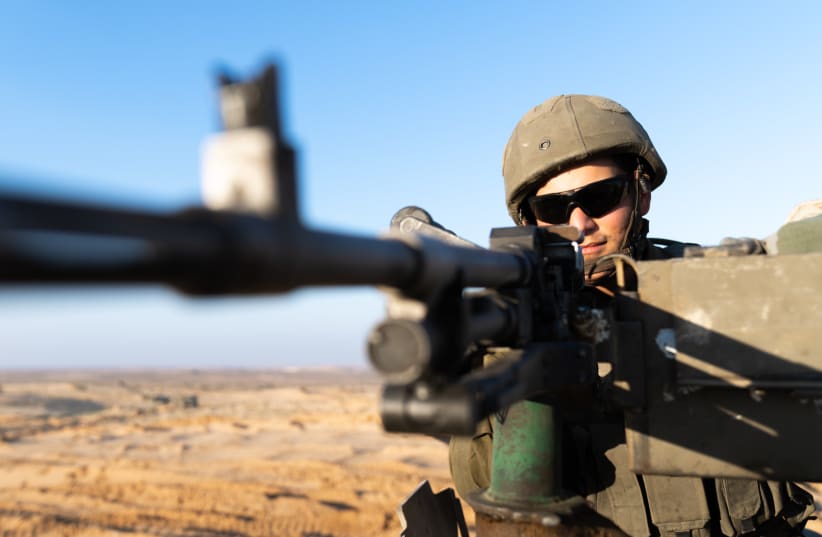If Israel goes to war with Hezbollah, IDF artillery will hit Lebanon with “thousands of shells per day,” Lt.-Col. El-Chai Cohen told The Jerusalem Post.
Cohen, the commander in charge of training for land forces artillery officers, spoke to the Post in the midst of a 10-day-long artillery drill.
However, what classifies as “artillery” today is completely different from the traditional definition. It now includes attack and intelligence-collection drones. In fact, 60% of current “artillery” forces are non-traditional – either drones, attack rockets or other methods of attack.
Also, Cohen’s land forces have much longer ranges, precision weapons and increased maneuverability than in the past, which radically changes their ability to shape the battlefield.
“We train artillery personnel, the next commanders, which is a big responsibility,” he said. “In the battle we imagine as the next war, artillery firepower will be very decisive. It is hard to conceptualize the full scope of our firepower capability. In the next war, it will not have ‘just’ jumped by 100%, it will be the heart of any new major conflict.”
In other words, he was warning Hezbollah that Israel’s artillery would overwhelm it in ways it cannot imagine. Though he said “we are looking at and ready on all fronts,” including against Hamas, from artillery’s perspective, the biggest conflict it needs to be ready for is with Hezbollah.
“We train artillery personnel, the next commanders, which is a big responsibility. In the battle we imagine as the next war, artillery firepower will be very decisive. It is hard to conceptualize the full scope of our firepower capability.”
IDF Lt.-Col. El-Chai Cohen told The Jerusalem Post
The 10-day drill is important
Next, Cohen said the significant length of the 10-day drill was important in order to “simulate that there are lots of dilemmas in the middle of a war. We need to see what a general war would really be like in the North and to feel the central role of artillery firepower.”
Asked to compare the IDF’s current artillery capabilities to previous ones, he said, “There will be much more firepower than in the past. There will be more integration of intelligence and firepower, with artillery being the tip of the spear of intelligence. And since intelligence must be much better, the precision of artillery will also be improved. Our capabilities are very diverse. We also have visual and intelligence collection capabilities. We have both unguided artillery bombardment munitions and precision munitions.”
Moreover, Cohen explained that current artillery units give the IDF “the maximum number of possibilities, advanced options and parameters for using force. The act of firing is now connected to all of the other forces, which was a big part of what we were working on during the current training drill.”
Regarding the challenge of avoiding civilian casualties in an urban setting, he said that “the enemy is using civilian shields, which is immoral. The fact they are doing that just means that we need to be even more precise so the harm to civilians will be minimized. We saw this during the May 2021 Operation Guardian of the Walls [against Hamas] and some other operations not long before that.
“Any weapon we need to achieve precision in urban settings we possess,” he said. “It has gotten dramatically better, but it is still a challenge. We have the capability to impose [our dominance] at a very high level – even if [urban settings] are challenging – much better now than even in the past.”
Cohen added that as a commander who participated in Operation Protective Edge against Hamas in Gaza in 2014, “We have elevated our performance on many levels since then.”
If in 2014, artillery might only have been accurate within a few hundred meters, precision munitions can now be accurate within single digits.
Discussing some of the IDF’s restraint to limit civilian casualties during the May 2021 Gaza War, he said, “There were areas we knew we could not fire at or where we only fired after others checked that we would only be hitting those who we needed to strike. Definitely there were multiple cases where we could have fired and canceled the attack” because of civilians in the area or where his forces delayed their attack to enable the use of “a less heavy and more precise munition.”
Comparing his forces’ precision capabilities to the IDF’s air-power capabilities, Cohen said that “We try not to be the air force or to have the same level of precision. Sometimes massive firepower is at the expense of precision, but we can still adjust our aim to hit specific areas with a certain level of precision. This gives us added value in any war.”
Questioned about how maneuverable current artillery forces are, Cohen said that “The artillery has been in every war: the Yom Kippur War, the First Lebanon War – wherever we were needed. We can always maneuver to different locations. But now our maneuvering capabilities have improved even more and our longer ranges for striking [targets] make us deadlier and more effective.”
Asked about how he simulated difficult battle conditions, the artillery commander said the soldiers he trained learned “how to fire when under threat. They know how to fire while being shot at simultaneously. They also simulate dealing with troops dying and being injured and evacuated.”
It is important for artillery commanders to know “how to act when they lose part of their personnel or forces,” he said. “They need the capability to take in their surroundings strategically and tactically and to keep up attacking at a fast pace.”

